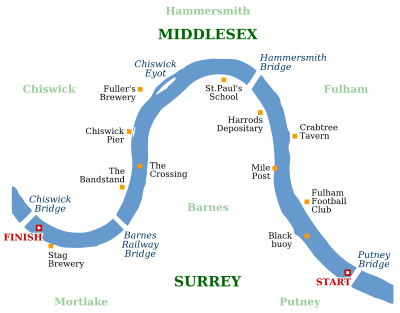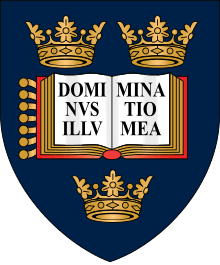The Boat Race 1979
| 125th Boat Race | |||
|---|---|---|---|
| Date | 17 March 1979 | ||
| Winner | Oxford | ||
| Margin of victory | 3 1/2 lengths | ||
| Winning time | 20 minutes 33 seconds | ||
| Overall record (Cambridge–Oxford) | 68–56 | ||
| Umpire |
Ronnie Howard (Oxford) | ||
| Other races | |||
| Reserve winner | Goldie | ||
| Women's winner | Cambridge | ||
| |||
The 125th Boat Race took place on 17 March 1979. Held annually, the event is a side-by-side rowing race between crews from the Universities of Oxford and Cambridge along the River Thames. The 150th anniversary race was won by Oxford by three-and-a-half-lengths. For the first time in 50 years, neither crew featured foreign rowers, while Cambridge's stroke was replaced just hours before the race. Goldie won the reserve race in the slowest time in the history of the race while Cambridge won the Women's Boat Race.
Background
The Boat Race is a side-by-side rowing competition between the University of Oxford (sometimes referred to as the "Dark Blues")[1] and the University of Cambridge (sometimes referred to as the "Light Blues").[1] The race was first held in 1829, and since 1845 has taken place on the 4.2-mile (6.8 km) Championship Course on the River Thames in southwest London.[2][3] The rivalry is a major point of honour between the two universities, as of 2014 it is followed throughout the United Kingdom and broadcast worldwide.[4][5][6] Oxford went into the race as reigning champions, having won the 1978 race after Cambridge sank. Cambridge, however, led overall with 68 victories to Oxford's 55.[7] The race was sponsored for the third consecutive year by Ladbrokes.[8] Former Oxford Blue Ronnie Howard was the umpire for the race.[9] To allow for television viewing, the start time of the race (2 p.m.) was an hour earlier than the traditional flood tide.[10]
The first Women's Boat Race took place in 1927, but did not become an annual fixture until the 1960s. Up until 2014, the contest was conducted as part of the Henley Boat Races, but as of the 2015 race, it is held on the River Thames, on the same day as the men's main and reserve races.[11] The reserve race, contested between Oxford's Isis boat and Cambridge's Goldie boat has been held since 1965. It usually takes place on the Tideway, prior to the main Boat Race.[7]
Oxford were being coached for the sixth consecutive time by Daniel Topolski who had himself rowed in the 1967 and 1968 races.[12] As coach, Topolski had suffered just one defeat.[8] Cambridge's head coach was Czechoslovakian former international rower Bohumil Janoušek; although a double Olympic medallist, he was still cautious of the event: "It's a peculiar race. The distance, the bends, the fact that only two crews race, the fact that during the course you encounter all sorts of water and wind conditions."[12] Janoušek had been employed in order to prevent Cambridge losing for the fourth consecutive time, an occurrence which last took place following the 1912 race.[8] Preparations for the race were hampered by appalling weather conditions: horizontal sleet and snow made practice rows challenging.[13]
Crews
Both crews weighed an average of 13 st 4 lb (84.2 kg); Henderson, the Cambridge cox weighed 13 pounds (5.9 kg) more than his Dark Blue counterpart.[14] In the week leading up to the race however, Cambridge's Andy Grey was struck down by gastroenteritis. While he recovered, his roommate John Woodhouse became ill and withdrew from the race three hours prior to the event. Woodhouse was replaced by Graham Phillips (who weighed 8 pounds (4 kg) less than Woodhouse) and the Light Blue boat was reorganised, with Phillips rowing at three and Nick Davies moving to stroke.[10] Oxford's crew contained four returning Blues, with Boris Rankov making the second of what would become six appearances in the race. Cambridge welcomed back four Blue rowers and the cox Henderson, all of whom had rowed the previous year.[15]
| Seat | Oxford |
Cambridge | ||||
|---|---|---|---|---|---|---|
| Name | College | Weight | Name | College | Weight | |
| Bow | P. J. Head | Oriel | 12 st 4 lb | S. J. Clegg | St Catharine's | 13 st 0 lb |
| 2 | R. A. Crockford | Corpus Christi | 13 st 4 lb | A. H. Grey | Pembroke | 13 st 1 lb |
| 3 | R. J. Moore | St Edmund | 13 st 3 lb | A. G. Phillips | Jesus | 12 st 12 lb |
| 4 | N. B. Rankov | Corpus Christi | 14 st 5 lb | J. S. Palmer | Pembroke | 14 st 2 lb |
| 5 | J. R. Crawford | Pembroke | 14 st 0 lb | A. N. de M. Jelfs | Fitzwilliam | 13 st 4 lb |
| 6 | C. J. Mahoney | Oriel | 13 st 4 lb | P. W. Cross | Downing | 12 st 11 lb |
| 7 | A. J. Wiggins | Keble | 13 st 4 lb | R. C. Ross | Lady Margaret Boat Club | 14 st 4 lb |
| Stroke | M. J. Diserens | Keble | 12 st 9 lb | R. N. E. Davies | St Catharine's | 13 st 5 lb |
| Cox | C. P. Berners-Lee | Wadham | 7 st 9 lb | G. Henderson | Downing | 8 st 8 lb |
| Source:[14] (P) – boat club president | ||||||
Race

Oxford won the toss (for the fifth consecutive year) and elected to start from the Surrey station. Conditions were calm – Desmond Hill writing in The Daily Telegraph described the river as "glassy" – and the tide, as a result of the earlier start time, was very weak.[10] The two boats were at 45 degrees to one another as the umpire dropped the flag to signal the start and within a minute, Oxford were clear of Cambridge. Oxford held a lead of two lengths by Craven Cottage and passed the Mile Post five seconds ahead, and extended their lead to eight seconds by the time the crews shot Hammersmith Bridge. Davies brought two two pushes out of the Light Blues at Chiswick Eyot but Oxford maintained their lead and passed the finishing post in 20 minutes 33 seconds, three-and-a-half lengths ahead of Cambridge.[10][16] It was Oxford's fourth consecutive victory and their fifth in six years.[7]
Taking place 30 minutes before the main race, the reserve race saw Cambridge's Goldie defeat Oxford's Isis by twelve lengths and thirty seconds.[10] As of 2014, the winning time of 22 minutes 50 seconds is the slowest time in the history of the event. It was Goldie's third consecutive victory, and their eleventh in thirteen years.[7] Cambridge won the 34th Women's Boat Race, making it their third in a row, and their sixteenth victory in seventeen years.[7]
Reaction
Oxford cox, Peter Berners-Lee suggested: "I got some help from the tide at the beginning, but very little later. I was expecting a neck-and-neck race and I couldn't believe we were a length up at Fulham."[17]
References
Notes
- 1 2 "Dark Blues aim to punch above their weight". The Observer. 6 April 2003. Retrieved 20 August 2014.
- ↑ Smith, Oliver (25 March 2014). "University Boat Race 2014: spectators' guide". The Daily Telegraph. Retrieved 20 August 2014.
- ↑ "The Course". The Boat Race Company Ltd. Retrieved 20 August 2014.
- ↑ "Former Winnipegger in winning Oxford–Cambridge Boat Race crew". CBC News. 6 April 2014. Retrieved 20 August 2014.
- ↑ "TV and radio". The Boat Race Company Ltd. Retrieved 5 July 2014.
- ↑ Markovits, Andrei; Rensmann, Lars (6 June 2010). Gaming the World: How Sports Are Reshaping Global Politics and Culture. Princeton University Press. pp. 287–288. ISBN 978-0691137513.
- 1 2 3 4 5 "Boat Race – Results". The Boat Race Company Ltd. Retrieved 20 August 2014.
- 1 2 3 Hill, Desmond (17 March 1979). "Oxford odds on to make it four wins in a row". The Daily Telegraph. p. 31.
- ↑ Hill, Desmond (14 March 1979). "Jekyll-and-Hyde form by Oxford". The Daily Telegraph. p. 35.
- 1 2 3 4 5 6 Hill, Desmond (19 March 1979). "Easy for Oxford as Cambridge stroke goes sick". The Daily Telegraph. p. 31.
- ↑ "A brief history of the Women's Boat Race". The Boat Race Company Limited. Archived from the original on 6 October 2014. Retrieved 5 July 2014.
- 1 2 Jennings, Roger (11 March 1979). "Chasing the Dark Blues away". The Guardian. p. 29.
- ↑ Hill, Desmond (16 March 1979). "Cambridge battle against blizzard". The Daily Telegraph. p. 35.
- 1 2 Hill, Desmond (13 March 1979). "Shock as crews weigh in". The Daily Telegraph. p. 34.
- ↑ Dodd, p. 347–48
- ↑ Dodd, p. 348
- ↑ Jennings, Roger (18 March 1979). "Stroke of bad luck". The Observer. p. 31.
Bibliography
- Dodd, Christopher (1983). The Oxford & Cambridge Boat Race. Stanley Paul. ISBN 0091513405.

